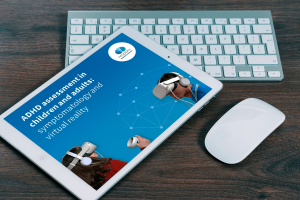ℹ️ Artículo disponible también en español.
Imagine this: optimised clinical processes to the maximum with the most advanced technology at your service. The use of Virtual Reality in your practice has great advantages: save time and perform more accurate assessments with objective measurements and easy monitoring of the effectiveness of the treatments. As a result, you’ll get increased visibility and a better reputation for your practice and therefore, more and more patients.
Virtual reality is the present ‘future’
You’ve surely heard of its use in engineering, design, business, art or entertainment, but do you know how VR can benefit you in your work as a health professional?
Virtual reality in medicine generates data that allows the development of new models, training, information and interactions. The possibilities are almost endless; let’s see how you can take advantage of them, both in training and in assessment and treatment.
Professional training to foster technological advance
2020 was the year when we as a society introduced the massive use of ICTs in classrooms and universities, and we abruptly needed to drive many social aspects through it. In this previous article on memory and virtual reality, we already talked about its use in education and how this Florida school developped a virtual campus in which teachers and students interacted in a “metaverse” through their avatars.
More and more training in medicine and surgery is turning to virtual reality, as it allows the anatomy of patients to be replicated and to operate virtually on personified avatars, as a test, before doing so on real patients.
Virtual reality is present in the academic field as part of the training curriculum in psychology and neuroscience and even as an active learning experience. Psychology students at this University in the Dominican Republic, for example, not only learned about the theoretical concepts of panic disorder but were also able to experience it “in their own skin”.

Psychological assessment through virtual reality
As knowledge about brain anatomy and precision in measurement tools moves forward and is more and more shared, we are able to more effectively relate the results to the problems faced and treated. An accurate and objective evaluation of the variables involved in psychological and neurological problems is key to a correct diagnosis, as well as to follow-up treatment.
The introduction of VR helps to achieve this accuracy and objectivity when evaluating attention, memory and/or cognitive processes. Unlike classic tests, virtual reality reproduces three-dimensional environments with which the patient interacts dynamically, with a feeling of immersion similar to that of a real environment. Virtual reality, as well, makes it possible to systematically control the presentation of different variables, stimuli and distracting pushes. The answers of the test are monitored and thanks to the ecological validity, they are more consistent compared to the results obtained through traditional tests.
At Nesplora we take advantage of the virtues offered by VR and technology to create neuropsychological assessment tools. Our products, unlike traditional tests and others, use virtual reality to empower the quality of the professional diagnose and intervention.

- Nesplora has the support and background of more than enough evidence: + 600 scientific publications
- Nesplora offers the most complete reports, with graphs, tables and interpretation of results
- Allows professionals to collect and monitor more data, and more accurately
- Eliminates correction biases thanks to their automatic reports
- Nesplora tests are also free from evaluator bias and cultural biases
- Our tests have CE marking, Medical device certificate and the EU Seal of Excellence
Professionals in over more than 30 countries who already use Nesplora have increased quality while reducing cost and time in their evaluations thanks to virtual reality.
Do you want to know the 11 reasons why virtual reality improves the profitability of your practice? Download this guide and go over them.
Virtual Reality and treatments
In addition to assessment, having virtual reality in your practice will help you treating numerous pathologies:
- Anxiety disorders
- Posttraumatic Stress Disorder
- Specific Phobias
- Social phobia
- Claustrophobia and Agoraphobia
- Generalised anxiety
- Addictions
- Eating disorders
- Schizophrenia
- Cognitive rehabilitation
- Relaxation techniques and pain distraction
Exposure therapy
Virtual reality therapy allows individualised, gradual, controlled and immersive exposure. For professionals, it is very easy to implement and for patients, it is often more desirable and attractive than live or imaginal exposure. Its efficacy has been shown to be slightly superior to classical exposure and its improvements more durable in long-term monitoring. It also reduces the dropout rate and the cost of therapy.Virtual reality therapy allows individualised, gradual, controlled and immersive exposure. For professionals, it is very easy to implement and for patients, it is often more desirable and attractive than live or imaginal exposure. Its efficacy has been shown to be slightly superior to classical exposure and its improvements more durable in long-term monitoring. It also reduces the dropout rate and the cost of therapy.
Rehabilitation
Virtual reality rehabilitation is carried out through training with exercises in virtual environments that can be designed and modified by the professional according to the needs and progress of the patient.
Pain distraction
Virtual reality has been shown to help significantly on reducing pain, anxiety, and discomfort for patients with various conditions. Thanks to the virtual reality equipment, the patients redirect their attention from a real situation, the source of discomfort, towards a perceptually pleasant alternative world full of characters, landscapes and activities with which they can interact.
5 Tools for virtual reality treatment in your practice
- Amelia Virtual Care, from Psious. A virtual reality platform for mental health professionals. Since 2014 they have been developing hardware, software and specialised training for the virtual reality treatment of specific phobias (aerophobia, acrophobia, agoraphobia), anxiety, etc.
- Avatar therapy. A programme designed for the treatment of schizophrenia and other psychotic disorders, particularly auditory hallucinations. It allows patients to “put a face to their voices” in order to interact with and challenge them, gradually, under the direction of the therapist.
- NEUROVR 2.0. A free virtual reality platform that has 25 pre-designed scenarios where you can adapt the content to the clinical purpose you are treating (phobias, eating disorders, etc.)
- V Store. A neuropsychological rehabilitation cognitive training of executive functions. A supermarket is recreated in virtual reality where the patient has to solve a series of tasks designed to stimulate the damaged functions in a programmed and personalised way.
- Snow World. This virtual reality video game was designed by researchers at the University of Texas to relieve the pain caused by burns. SnowWorld is an ice environment where the patient must throw snowballs at penguins that appear non-stop. As simple as it sounds, the results indicate that it reduces pain similar to a moderate dose of pain medication.
If this article has motivated you to take advantage of virtual reality, start by optimising your assessments and join the professionals who are at the forefront of Neuroscience.
ADHD assessment in children and adults: symptomatology and evaluation with VR












